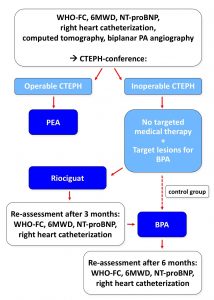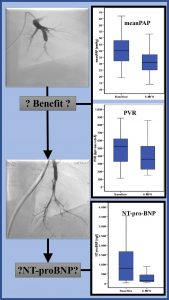
Chronic thromboembolic pulmonary hypertension (CTEPH) is a common form of pulmonary hypertension. Up to 5% of patients who survive acute pulmonary embolism will develop CTEPH.
Proximal and distal stenoses and occlusions of pulmonary artery branches lead to pulmonary hypertension. Pulmonary endarterectomy is the treatment of choice. However, up to 1/3 of CTEPH patients are not operable. These patients are treated medically and only few undergo balloon pulmonary angioplasty (BPA). As the evidence for BPA is still scarce (lack of long-term data and controlled clinical trials), this interventional therapy is not clearly recommended in guidelines (IIb C). Therefore, data analyzing patients undergoing BPA are warranted.
Authors
Christoph Liebetrau, MD1,2; Christoph B Wiedenroth, MD3
- Kerckhoff Heart and Thorax Center, Department of Cardiology, Bad Nauheim, Germany; German Center for Cardiovascular Research (DZHK), Partner Site Rhine-Main, Frankfurt am Main, Germany
- Justus Liebig University Giessen, Medical Clinic I, Division of Cardiology, Giessen, Germany
- Kerckhoff Heart and Thorax Center, Department of Thoracic Surgery, Bad Nauheim, Germany
CTEPH can be treated curatively by pulmonary endarterectomy (PEA). However, up to one-third of all CTEPH patients are not operable.1 Balloon pulmonary angioplasty (BPA) is an emerging treatment for patients with inoperable CTEPH, but less is known about the persistent procedural success of BPA.2 Thus, the central objective was to establish a comprehensive database collecting all available clinical, haemodynamic, functional, and clinical chemistry data. In parallel, a biobank as part of the Kerckhoff Biomarker Registy with blood specimens from CTEPH patients, pre- and post-BPA was established to complement findings from the analysis of clinical data.
The Kerckhoff Heart and Thorax Center
The Kerckhoff Heart and Thorax Center, Bad Nauheim, Germany, serves as a national referral centre for PEA surgery with more than 100 PEA procedures per year. The CTEPH diagnosis is established according to current guidelines. Non-operability was evaluated in a multidisciplinary conference including thoracic surgeons, cardiologists, pulmonologists, radiologists, anaesthesiologists, and intensive care specialists. Patients finally classified as non-operable were treated with PAH-specific medication, and balloon pulmonary angioplasty (BPA) is offered if target lesions have been detected (Fig. 1). At admission for scheduled BPA, patients were asked to participate in the registry and to sign the informed consent form. The study was approved by the ethics committee of the Justus-Liebig-University Giessen, Germany, (AZ 44/14) and is in accordance with the Declaration of Helsinki.

The BPA programme at the Kerckhoff Heart and Thorax Center began in March 2014. Since then, more than 120 patients have undergone BPA and a six-month on-site follow-up completed the dataset. All patients underwent right- and left-heart catheterisation, pulmonalis angiography, six-minute walk distance, echocardiography, spiroergometry and CT-scan. BPA was performed as a staged procedure, with a limited number of pulmonary segments being treated during each session. All procedures were performed in conscious patients under local anesthesia (and light sedation, if required). The standard procedure has been described previously.3 Briefly, using femoral or jugular access, a sheath was placed in the pulmonary artery and a guiding catheter was inserted into the target segmental arteries. The guidewire was then advanced into the target subsegmental branches, which were subsequently dilated by multiple balloon inflations. A final pulmonary angiography documented the post-procedural morphological result.
In the current analysis, we evaluated N-terminal pro-hormone B-type natriuretic peptide (NT-proBNP) in patients undergoing BPA. The knowledge of NT-proBNP concentrations following BPA could aid the interpretation of the decrease in pulmonary arterial pressure (PAP) and pulmonary vascular resistance (PVR) and improvement of right heart function and therefore increase the accuracy of the risk stratification in these patients.
Venous blood samples for the determination of NT-proBNP were collected before every BPA procedure, and at the 6-MFU. NT-proBNP was measured in serum with an electrochemiluminescence immunoassay using monoclonal antibodies (NT-proBNP assay, Elecsys Analyzer 2010, Roche Diagnostics, Mannheim, Germany).
Analysis
The current analysis, comprises the first 51 patients (28 women, 23 men; mean [±SD] age 63.1±11.5 years). At baseline, 49 (96.1%) patients were in WHO functional class ≥III. All patients were on oral anticoagulation therapy for at least three months and 29 (56.9%) patients were undergoing specific medical treatment for pulmonary hypertension. A total of 265 (mean 5/patient) BPA interventions treating a total of 410 (mean 8/patient) vessels were performed. The most common complications were reperfusion injury in 3.4% and hemoptysis in 7.4% of all interventions. The six-month survival rate was 96.1%. At the 6-MFU the WHO functional class was improved (P<0.001) with 6 (11.8%) patients in WHO class ≥III. The median six-minute walk distance increased significantly (BL: 375.0 m [IQR 281-445.5] vs. 6-MFU: 409 m [332.3-445.8]; P=0.017). The meanPAP at baseline was 39.5±12.1 mmHg and decreased after BPA treatment to 32.6±12.6 mmHg (P<0.001). In parallel, the PVR decreased from 516±219 dyn×sec×cm-5 to 397±183 dyn×sec×cm-5 (p<0.001) (Fig. 2).

Comparison of serum NT-proBNP concentrations with BL values revealed a significant decrease at all pre-specified time points following the first BPA, with the lowest value being measured at the 6-MFU (821 ng/l [IQR 153-1871.5] vs. 159 ng/l [84.4-464.3]; P<0.001) (Fig. 2). Out of 51 patients, 37 showed a significant decrease (≥25%) of NT-proBNP at the 6-MFU with a mean percent reduction of 53.6% (IQR 22.4-85.5) (range of percent change [min-max]: +265 to -98%; range of absolute change [min-max]: +8919 to -8377 ng/l). When we compared patients with a significant reduction of the NT-proBNP level at the 6-MFU with those without a reduction, a higher initial NT-proBNP level was the only significant (P=0.010) difference at BL. The percent reduction of PVR (P=0.002) and the percent reduction of the meanPAP (P=0.007) were significantly greater among patients with a significant decrease in NT-proBNP level ≥25%.
The main findings of this observation are: 1) staged BPA results in a substantial decrease in NT-proBNP concentrations in most of the patients that is already significant after the first BPA procedure; 2) this NT-proBNP decrease is associated with a significant reduction of meanPAP and PVR and indicates the procedural success of BPA; 3) the 40% reduction of post-procedural NT-proBNP six months after BPA indicates a meanPAP decrease ≥25% and a reduction of 60% indicates a PVR decrease ≥35%.
NT-proBNP levels were measured at BL and immediately in advance to each consecutive BPA session, which lead to an interval of four to eight weeks between a BPA session and the subsequent NT-proBNP measurement. Thus, the NT-proBNP level is an indicator for the movement of cardiac wall stress since the previous treatment session, although it is not known how long it definitely takes for a single angioplasty to reach its steady state hemodynamic effect. Only 12 out of 51 patients showed no significant changes in NT-proBNP concentrations under treatment. These patients were characterized by a significantly smaller decrease in meanPAP and PVR during follow-up. Our data indicates that consecutive NT-proBNP measurement under staged BPA therapy might help to assess the effects of BPA on hemodynamics and right ventricular function, which would lead to a better monitoring of BPA success.
The results indicate that NT-proBNP is able to discriminate patients who profit from BPA regarding the improvement of pulmonary hemodynamics and therefore by improvements in right ventricular function. This assumption is strengthened by the fact that the BPA itself lowers the PVR and meanPAP and therefore the ventricular wall stress and hence leads to a decrease in natriuretic peptide levels. Measurement of NT-proBNP concentrations allows discrimination of patients who do not respond to the procedure with a lowering of PAP and PVR, which should be helpful in the identification of patients at risk.
References
- Delcroix M, Lang I, Pepke-Zaba J, Jansa P, D’Armini AM, Snijder R, Bresser P, Torbicki A, Mellemkjaer S, Lewczuk J, Simkova I, Barberà JA, de Perrot M, Hoeper MM, Gaine S, Speich R, Gomez-Sanchez MA, Kovacs G, Jaïs X, Ambroz D, Treacy C, Morsolini M, Jenkins D, Lindner J, Dartevelle P, Mayer E, Simonneau G. Long-Term Outcome of Patients with Chronic Thromboembolic Pulmonary Hypertension (CTEPH): Results From an International Prospective Registry. Circulation. 2016; 133: 859-71
- Muller DWM, Liebetrau C. Percutaneous treatment of chronic thromboembolic pulmonary hypertension (CTEPH). EuroIntervention 2016;12:X35-X43
- Olsson KM, Wiedenroth CB, Kamp JC, Breithecker A, Fuge J, Krombach GA, Haas M, Hamm C, Kramm T, Guth S, Ghofrani HA, Hinrichs JB, Cebotari S, Meyer K, Hoeper MM, Mayer E, Liebetrau C, Meyer BC. Balloon pulmonary angioplasty for inoperable patients with chronic thromboembolic pulmonary hypertension: The initial German experience. Eur Resp J. 2017; 49 (6): doi: 10.1183/13993003.02409-2016
- Kriechbaum SD, Wiedenroth CB, Wolter JS, Hütz R, Haas M, Breithecker A, Roller FC, Keller T, Guth S, Rolf A, Hamm CW, Mayer E, Liebetrau C. N-terminal pro-B-type natriuretic peptide for monitoring after balloon pulmonary angioplasty for chronic thromboembolic pulmonary hypertension. J Heart Lung Transplant. 2017; DOI: http://dx.doi.org/10.1016/j.healun.2017.12.006







